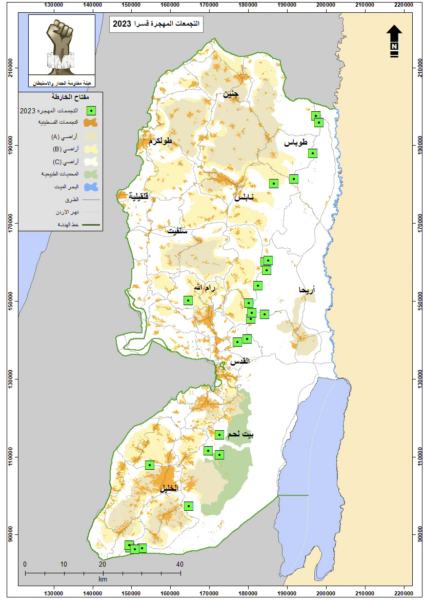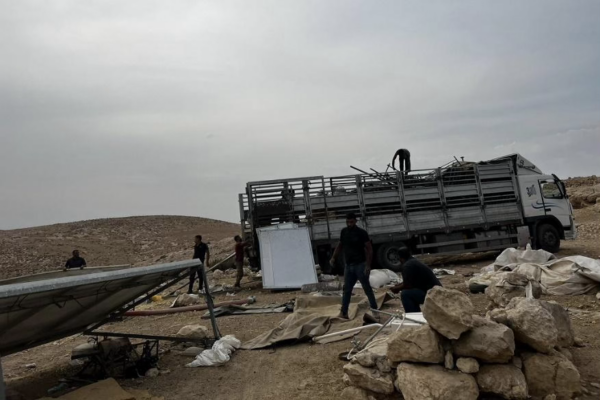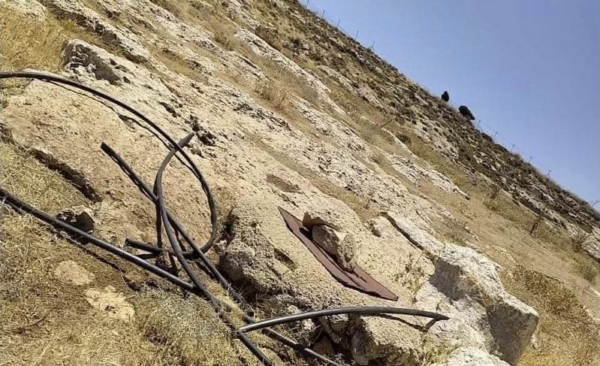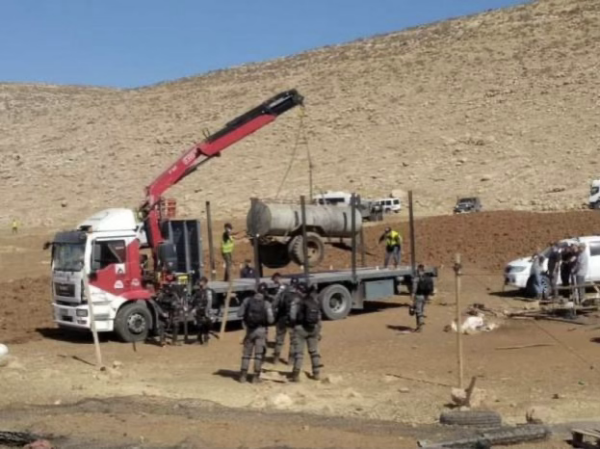This report was generated by the Commission Against the Wall and Settlements, and was translated from Arabic to English for ISM. That translation is reproduced here with only minor formatting alterations.
Agricultural Outposts: A Gateway towards Forced Displacement
It is not possible to create a functional separation between the case of establishing colonial outposts, which witnessed a rise in their creation process after 2015, and the case of forced displacement taking place these days, which reached its peak shortly after the aggression began on October 7th, 2023. The state of emergency and the declaration of war served as a cover for the behavior of colonizers’ militias whose original aim was to create this type of displacement. This is a form of a functional exchange of roles between the official institutes affiliated with the occupation and these militias.
Data from the Colonization and Wall Resistance Commission (CWRC) point to the existence of 96 active colonial outposts taking on the forms of pastoral and agricultural outposts out of a total of 196 diverse colonial outposts (updated data/Commission). These outposts prevent Palestinian citizens from “using/accessing” more than 410,000 dunums of privately owned citizens’ lands in various areas in the West Bank, mostly concentrated in the eastern slopes and the Jordan Valley. This is done without official military orders and without declared procedures, merely under the control of terrorism, domination, and official military protection.
The attached map shows how the positioning of the outposts, that were built purposefully alongside Bedouin communities, led to the forced displacement of these communities because of the behavior of armed extremist colonizers and their aggressive implementation of these evacuation plans. This was achieved by depriving these communities from grazing areas and water resources, in addition to instilling fear in the hearts of the elderly, women, and children, compelling them to leave. Data from the commission, alongside other human rights organizations, indicates that more than 27 Bedouin communities of various sizes were forcibly displaced in the year 2023 due to the terrorism emanating from these outposts.
This approach (colonial outposts vs forced displacement) is based on one of the main plans of the settler colonial project’s trajectories following the occupation in 1967, which was revealed in the same year and was attributed to the acting Prime Minister and Minister in the third occupation government, Yigal Allon. He gave a proposition to empty the eastern slopes of the West Bank, annex the city of Jerusalem, and gain control over Palestinian natural resources (see the side map).
By following the occupation’s colonial behavior through the past decades, one can come to the conclusion that the occupation state did not deter, not for one minute, from implementing this particular plan, in addition to several other prominent plans, notably, Matityahu Drobles Plan of 1978 (former head of the colonial division). Drobles proposed annexing the eastern slopes, and reinforcing colonial blocs, which has remained steadfast and is being rapidly implemented. The implementation process began by isolating the Jordan Valley and evacuating it, and continued by instilling colonizers in pastoral and agricultural outposts, and culminated in the imposition of terrorism to accomplish the displacement process.
The CWRC data point out that 71% of these outposts were created after 2015. The Commission monitors that 78% of these outposts were established in the eastern part of the West Bank, starting from the northern part of the Jordan Valley, passing through the eastern part of Ramallah and Jerusalem, and ending in the southern part of the Hebron Governorate in the south, or in areas overlooking these regions, such as the eastern part of Nablus Governorate, forming a corridor in the operational sense of control.
Looking at the issue from the outside, it seems that these invented colonial stages, and in every stage, are separate from each other completely. This supports the occupation’s claim that there are security reasons and requirements for all these procedures. However, in truth, while reviewing this project in its cumulative dimension, and in a way that leaves no room for doubt, that there is a strong bond between these stages that goes way back to ancient origins and ideologies that were adopted since the beginning of the occupation. This connection does not relinquish control as a concept and does not loosen its grip on the land and its people as a practical on-the-ground measure.
Even though the settler-colonial project on Palestine has a long, ancient, and continuous history, on the other hand, the Palestinian legal and popular national struggle is no less rooted, authentic, and varied. It emanates from the concept of the inherent right and the struggle protected by all laws of the land and sky, preserved by the Palestinian people with unwavering determination.

Colonial Terrorism and Forced Displacement
In this part of the report, we document the forced displacement processes caused by the coercive and hostile environmental measures imposed by the occupation state’s direct measures and through the terrorism of colonizers’ militias imposed on Palestinian citizens in these areas.
The Colonization and Wall Resistance Commission, since the beginning of 2023, especially after the aggression on our people started after the 7th of October, monitored an escalation of the assaults and threats of armed colonizers, in what can be described as an audacious exploitation of the aggression waged on the Gaza Strip, taking advantage of the fact the media focus is on Gaza, and its absence from the West Bank and Jerusalem to some extent. Most importantly, there is an exploitation of the emergency and war laws imposed by the occupying state, which protect the criminals among the colonizers from accountability and punishment, particularly in the issues of forced displacement and the imposition of a coercive and hostile environment.
Even though all international laws and regulations prohibit and criminalize forced displacement, as stated in the Fourth Geneva Convention of 1949, Article 49, which declares: “The Occupying Power shall not deport or transfer parts of its own civilian population into the territory it occupies.” Similarly, Article 53, “Any destruction by the Occupying Power of real or personal property belonging individually or collectively to private persons, or to the State, or to other public authorities, or to social or co-operative organizations, is prohibited, except where such destruction is rendered absolutely necessary by military operations.” And Article 147, which declares, “extensive destruction and appropriation of property, not justified by military necessity and carried out unlawfully and wantonly.” (Fourth Geneva Convention on the Protection of Civilians in Time of War, 1949).
Judicial precedents from the International Criminal Court and other international criminal tribunals affirm that forced displacement is not limited to direct physical displacement but also encompasses actions and threats involving the use of force and coercion. It also includes creating a hostile environment, such as detention, violence, demolition, and other measures that forcibly drive individuals to leave their place of residence or to be displaced.
The Israeli occupation authorities, in the process of forced displacement of Palestinian Bedouin communities, focus on three main areas: the Palestinian Jordan Valley, the eastern region of Ramallah, and the southern part of Hebron. This is evident in the data on the positioning of the displaced communities. During the period covered by the report, the Israeli occupation procedures led to the forced displacement of 28 Bedouin communities.
| Community Name | Governorate | Number of Families | Number of Residents | Notes* |
| Zanuta | Hebron | 47 | 237 | Returned, then displaced again |
| Wadi as-Seeq | Ramallah | 28 | 144 | |
| Ein Ar-Rashash | Ramallah | 15 | 88 | |
| Al Baqa’a | Ramallah | 17 | 79 | |
| Jib’it | Ramallah | 17 | 86 | |
| Al-Mlihat/Abu Fazza’ | Ramallah | 6 | 47 | |
| Ar-Radim/As-Samou’ | Hebron | 3 | 32 | |
| Barriyat Ar-Rashaydeh | Kisan/Bethlehem | 4 | 16 | |
| Al-Aqbat/Hizma | Jerusalem | 7 | 51 | |
| Al-Qanoub | Hebron | 17 | 77 | |
| Almazra’a Al Gharbiyya | Ramallah | 2 | 9 | Partial |
| Taibe | Ramallah | 6 | 37 | |
| Al-Mu’arrajat community | Ramallah | 21 | 138 | |
| South of ‘Ein Shibli | Tubas | 3 | 28 | |
| Khirbat al-Taibe | Hebron | 11 | 53 | |
| Khallet al Hamra | Bethlehem | 2 | 11 | |
| Ein al Sukhun | Central Jordan Valley | 9 | 62 | |
| Um al Jamal | Jordan Valley | 14 | 84 | |
| Wadi al Faw | Jordan Valley | 2 | 13 | Partial |
| South of Nassariya | Nablus | 5 | 27 | |
| Maqtal Muslim | Hebron | 1 | 8 | |
| Einzan | Hebron | 4 | 35 | |
| Al-Buwaib | Hebron | 4 | 41 | Partial |
| Al-Qabbun | Ramallah | 11 | 84 | Pre-Oct-7 |
| Ein Samiya | Ramallah | 34 | 176 | Pre-Oct-7 |
| Tana | Beit Furiq/ Nablus | 36 | 140 | |
| Shua’ab Fursa | Masafer Yatta | 5 | 32 | |
| Beer al A’ad | 4 | Pre-Oct-7 | ||
| Kherbat Samri | 3 | 17 | Pre-Oct-7 | |
| Al Tawmin | 4 | 40 | Pre-Oct-7 | |
| Ras al Tin | Ramallah | 38 | 366 | Pre-Oct-7 |
| Al Wadi Al Ahmar | Jericho | 7 | 34 | Pre-Oct-7 |
| Ein Shibli | Jordan Valley | 3 | 28 | |
| Al Nassariya | East of Nablus | 7 | 56 | |
| Ein al Zira’a | Jordan Valley | 4 | 33 | |
| Wadi E’bayyat | Bethlehem | 2 | 12 | |
| TOTAL | 403 | 2421+ |

The Most Prominent Models of Forced Displacement in 2023
Case 1. The forced displacement of Wadi As-Seeq/East of Ramallah/Ramallah Governorate:

Following the aggression against the Palestinian people on the 7th of October, armed colonizers began a series of threats against the inhabitants of the community and the crews of the Colonization and Wall Resistance Commission, which had been stationed there for more than 45 days. At the time, 30 families, comprising approximately 180 individuals, including 40 minors, were residing in the area. In the evening hours of October 10, 2023, the families of the community began to evacuate the location in response to the colonizers’ threats.
- The community’s residents live in an area of approximately one square kilometer.
- The community includes a school built by the residents, accommodating 120 students.
- The inhabitants have been living in the location since the 1970s, relying on sheep farming for their livelihood.
- Since 1996, the residents have been consistently receiving notifications of the demolition of structures, tents, and barracks, under the pretext of their presence in a military zone, despite evidence that they are outside the designated firing range for training.
Case 2. The Forced Displacement of Khirbet Zanota, Adh Dhahiriya/ Hebron Governorate
Directly following Israeli colonizers made a series of attacks and violent threats, including threats of murder if they did not leave, 36 Palestinian families, comprising a total of 400 individuals, half of whom were children, were displaced from Khirbet Zanota in the southern part of the West Bank. On October 28, 2023, the residents dismantled around 50 tent and barrack structures, and evacuated the area along with their livestock, totaling 4,700 sheep.
- The land area of Khirbet Zanota in the southern Hebron Governorate is 12,000 dunams.
- All classified as Area C. It is surrounded on the west by the detour colonial road, on the east by the colonial industrial area, and on the south by the Annexation and Expansion Wall. On the north, the historical ruins of the village are surrounded by the colonies of “Metar, Tima, and Shim’a.”
- The displacement of these families grants the occupation control over more than 20,000 dunams of land surrounding the village.
- The school accommodates 43 students, including 10 children in kindergarten, along with several teachers. The school, which was targeted for demolition and reconstructed with “zinc” and brick panels, comprises 6 rooms, facilities, and a health unit.
- There is a provisional Israeli court decision protecting the colony’s buildings from demolition, issued in 2016.
- The colony has received demolition notifications, which have not been implemented, particularly targeting the Municipal Council building and the health clinic.
Case 3. The Forced Displacement of Ein Ar-Rashash/Thahr Al-Jabal/East of Ramallah:

Fifteen families, totaling 95 people, including 21 minors, used to reside in the area. On October 9, 2023, a group of colonizers blocked the road leading to the community’s residence. It is important to point out that the Israeli occupation army has blocked the road multiple times and the community managed to open it again. The colonizers also blocked the water tank from reaching the area forcing the community to relocate 1500 sheep to the village of Duma. By October 13, 2023, all women and children had relocated to the village of Duma, and on October 16, 2023, all the men joined them in the area next to the Duman village.
Case 4. The Forced Displacement of Khirbat Jab’it/North of Ramallah

Eight families, totaling 25 people, including 10 minors, resided in the area. On October 13, 2023, the community left the area due to colonizers’ threats. They left most of their possessions behind, fearing to retrieve them because of the ongoing threats and because the colonizers blocked the road leading to the area.
